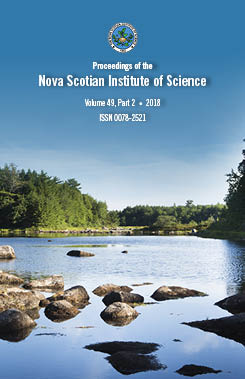Chemical light sticks as bait to trap predaceous aquatic insects: effect of light colour
DOI:
https://doi.org/10.15273/pnsis.v49i2.8162Abstract
We measured the efficiency of floating minnow-traps (Gee traps), unbaited or baited with red, green, blue, or white chemical light sticks (glowsticks) to trap large, predaceous, aquatic beetles (Coleoptera) and bugs (Hemiptera) in 50 fresh water, lentic systems in northern Nova Scotia, Canada. Standard minnow-traps buoyed with Styrofoam® floats were set overnight in a variety of freshwater habitats, including ponds, marshes, bog pools and vegetated lake margins throughout the ice-free seasons over three years, for a total of 695 trap-nights. Giant Water Bugs (Lethocerus americanus) were captured with equal frequency in traps baited with any colour glowstick and in unbaited controls. Brown Waterscorpions (Ranatra fusca) were significantly more abundant in light-baited traps than in dark controls, and showed a strong preference for green lures over other colours. The large, Vertical Diving Beetle Dytiscus verticalis was caught significantly more than expected with white or red lures and significantly less with green or blue lures; males were caught even less often with green or blue lures than in unbaited controls. Our results reveal a heretofore unknown component of the biology of these insects, and suggest a novel method for simple and effective sampling of aquatic insects in still waters.
Keywords: light; trapping; phototaxis; aquatic insects; colour


